#B47 Stratojet
Video
youtube
The B-47 Stratojet. The 6 Engined Nuclear Capable Strategic Bomber Built By Boeing #boeing #stratojet #strategicbomber #nuclear #nuclearbomb #airplane #aircraft
#youtube#boeing#strategic#nuclear#B47#b-47 stratojet#stratojet#nuclear bomb#aircraft#airplane#bomber#us air force
0 notes
Text
Ronnie Bell Following
BOEING B47-A
AIRCRAFT: BOEING B-47A
Wichita, Kansas, August 11, 1950 -- Boeing Airplane Company today released for the first time flight photographs of its newest model Air Force Stratojet bomber. The photographs were taken during a recent test flight near here of one of the production model B-47A Stratojets, fastest know bomber in the world. Boeing is building a substantial quantity of the Startojets at Witchita, the first of the new planes having been rolled March 1 from the assembly line. The swept-wing bomber has a top speed of more than 600 miles an hour. It is powered by six General Electric J-47 turbo-jet engines, has a maximum gross takeoff weight of more than 186,000 pounds and can carry more than 20,000 pounds of bombs. An earlier model Stratojet, one of the two original XB-47's, last year spnned the nation from Moses Lake, Washington, to Andrews Air Force Base, Maryland, in 3 hours 46 minutes at an speed of 607.8 miles per hour.
Via Flickr
7 notes
·
View notes
Photo
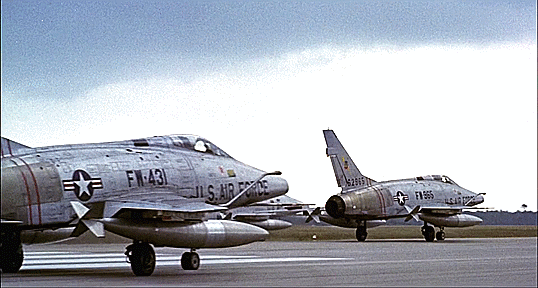
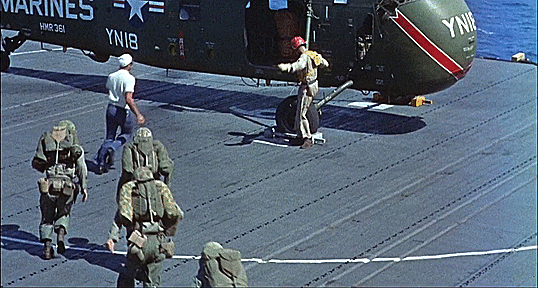
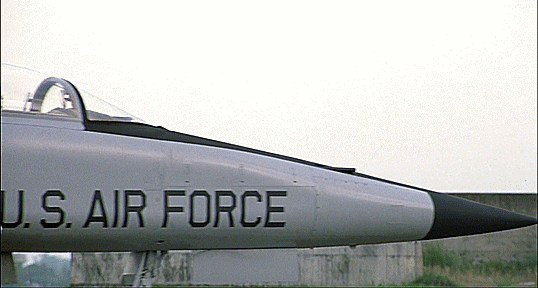
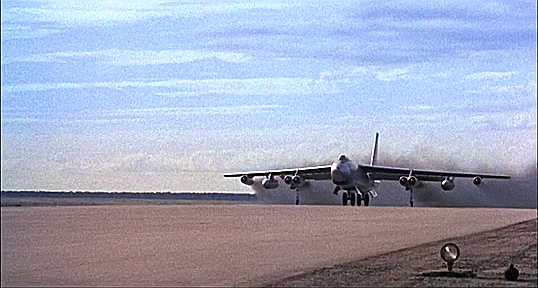





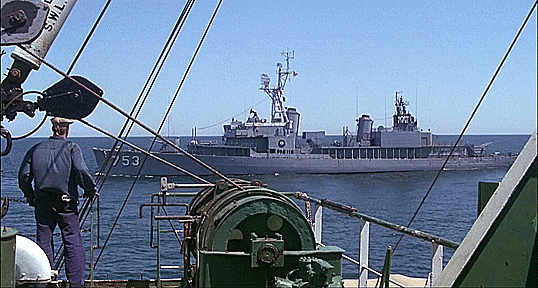
Thirteen Days + Military Hardware
#Thirteen Days#Cold War#Military Hardware#USAF#USN#GIF#my gifs#thirteendaysedit#Thirteen Days Rewatch#top to bottom#F100 Super Sabre#Sikorsky Sea Horse#Sikorsky HUS 1 Seahorse#F5 Freedom Fighter#B47 Stratojet#b52 stratofortress#(and some icbms)#RF8 Crusader#Vought Crusader#Aircraft Carrier#(wikipedia says the Enterprise was in use for this as era appropriate)#Atlas ICBM#SM 65 Atlas#A4 Skyhawk#US Navy Destroyer#Sumner Class#USS John R. Pierce#which is played by a museum ship#USS Joseph P. Kennedy Jr.#(also in this film)
278 notes
·
View notes
Photo

The Boeing B-47 Stratojet, the United States’ first swept wing multiengine jet bomber, laid out design features that would set the pattern for large jet aircraft for years to come- a swept wing with engines in nacelles cantilevered ahead and below the wings. Boeing’s engineers were looking at jet powered developments as early as 1943 that would lead to the evolution of the B-29 Superfortress into jet power- however, wind tunnel testing showed that straight wings which were a much better known design in aviation of the day simply could not handle the potential of jet engines. At the end of the Second World War, Boeing aerodynamicist George Schairer was on a fact-finding mission in areas of Germany in Allied hands and in a captured aeronautics laboratory, he reviewed some of the German wind tunnel data on swept wings and sent the information back to Seattle to incorporate a 35-degree swept wing on the jet bomber design. Initial designs had the J47 engines mounted in the fuselage, leaving an aerodynamically clean wing, but the USAF wanted the engines away from the fuselage for safety reasons. Further study showed that putting the engines in pods cantilevered on pylons below and ahead of the wings still allowed the wings to be efficient but were safer locations for the early engines. As a bonus, the weight of the engines on the wing also reduced bending moments which allowed for lighter and more efficient wing designs. The Stratojet made its first flight on 14 December 1947, the 44th anniversary of the Wright Brothers’ first flight at Kitty Hawk. The Stratojet was so radical at the time, some Boeing engineers were skeptical it would even fly! November Aviation Photo Challenge | @kjdphoto1971 | #1119planes | “1st Generation Jet” | Day 1 #avgeek #aviation #aircraft #planeporn #PimaAirandSpaceMuseum #Pima #Tucson #DavisMonthan #Arizona #airport #planespotting #instaplane #instagramaviation #Boeing #B47 #Stratojet #USAF #mil_aviation_originals #instaaviation #aviationlovers #aviationphotography #flight #AvgeekSchoolofKnowledge #AvGeekNation (at Pima Air & Space Museum) https://www.instagram.com/p/B4UWmzBBF5j/?igshid=ovckcjb41eoy
#1119planes#avgeek#aviation#aircraft#planeporn#pimaairandspacemuseum#pima#tucson#davismonthan#arizona#airport#planespotting#instaplane#instagramaviation#boeing#b47#stratojet#usaf#mil_aviation_originals#instaaviation#aviationlovers#aviationphotography#flight#avgeekschoolofknowledge#avgeeknation
9 notes
·
View notes
Photo

This Infographic Comparing Bomber Sizes Made Our Head Spin
The B-52 Stratofortress Is Not The Biggest.
We always like showing you folks something new. Like you, we’re aviation nuts so all we think about is how to present cool facts and videos to get younger generations interested in the topic. Here, we just wanted to present the insane differences in bomber different sizes.
For the sake of simplicity, as there are dozens upon dozens of bombers, we narrowed this list down to these by using the following criteria. The bombers in this infographic are U.S. made, built between 1938 and present that were most produced during the decade. We graded the size of them by the length of their wingspan rounded to the nearest foot. That’s about it.
http://worldwarwings.com/infographic-comparing-bomber-sizes-made-head-spin/
#b36#peacemaker#b52#stratofortress#b2#spirit#b29#superfortress#b1#lancer#b47#stratojet#b24#liberator#b17#flying fortress#b25#mitchell#b58#hustler#b-36#b-52#b-2#b-1#b-29#b-47#b-24#b-17#b-25#b-58
657 notes
·
View notes
Photo
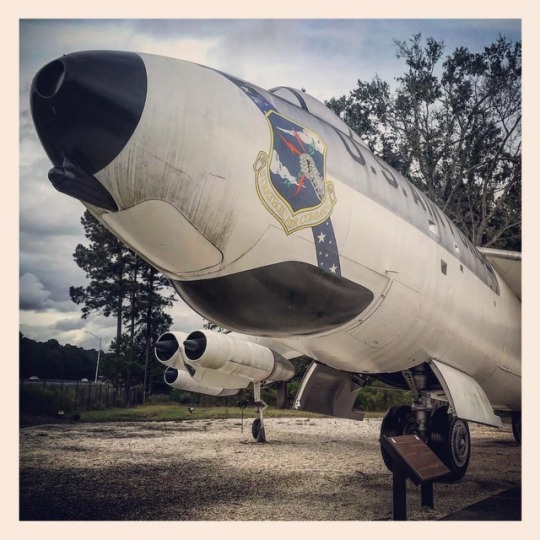
#pooler #georgia #poolerga #mighty8thairforcemuseum #airforce #museum #airplane #b47 #stratojet #plane #bomber (at National Museum of the Mighty Eighth Air Force) https://www.instagram.com/p/BpxqW4Ynxc8/?utm_source=ig_tumblr_share&igshid=1jg2p9wnq1olu
#pooler#georgia#poolerga#mighty8thairforcemuseum#airforce#museum#airplane#b47#stratojet#plane#bomber
0 notes
Photo

Boeing B-47 Stratojet was an American six engine, turbojet-powered, long range strategic bomber. It was the United States Air Force’s Strategic Air Command (SAC) mainstay during the 50′s and early 60′s.
#Vbeserk#Boeing#B47#Stratojet#USAF#SAC#Strategic#Bomber#Long#range#aircraft#airplane#aviation#Cold War
48 notes
·
View notes
Photo
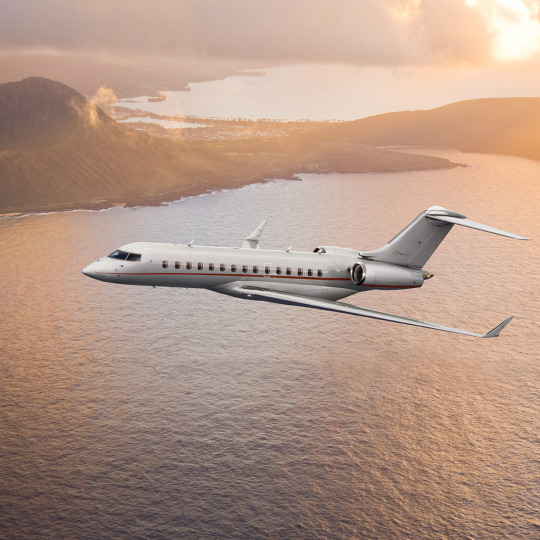
Lancé en 1943,le Boeing B-47 Stratojet entre en service 1951 dans la l'United States Air Force (USAF)
#Boeing #B47 #Airforce #unitedstate #fly
0 notes
Text
If you’re ever in South Carolina, stop and enjoy the historical delights of the Pee Dee region. About a half-hour from Pedro’s “South of the Border”, there you will find the “All-American City” of Florence, according to the National Civic League of 1965. With a population of about 38,000, Florence describes itself as a regional center for business, medicine, culture and finance.
Oh, and the Federal Government dropped a nuke on the place. Sixty years ago, today.
To anyone under the age of 40, the Cold War must seem a strange and incomprehensible period. Many of us who lived through it, feel the same way. The Air Force Boeing Stratojet bomber left Hunter Air Force Base in Savannah, on a routine flight to Africa via the United Kingdom. Just in case nuclear war was to break out with the Soviet Union, the B47 carried a 10’8″, 10,900lb, Mark 4, atomic bomb.
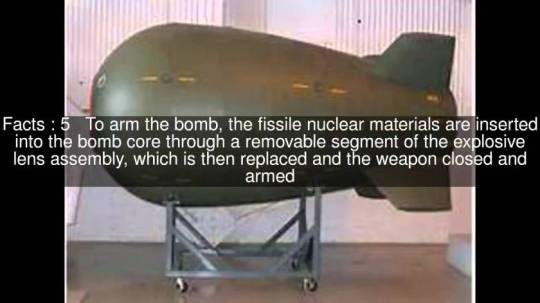
The Atlantic Coastline Railroad conductor, WWII veteran & former paratrooper Walter Gregg Sr. was in the workshop near his home in the Mars Bluff neighborhood of Florence, South Carolina while his wife, Ethel Mae “Effie” Gregg, was inside, sewing. The Gregg sisters Helen and Frances, ages 6 and 9, were playing in the woods with their nine-year-old cousin Ella Davies, as the B47 Stratojet bomber lumbered overhead.
At 15,000 ft., a warning light came on in the cockpit, and the pilot accidentally pulled the emergency release pin. Bomb bay doors alone are woefully inadequate to hold a five-ton bomb. The thing broke free and began its 15,000-ft. descent, straight into the Gregg’s back yard.
The Mark 4 atom bomb employs an IFI (in-flight insertion) safety, whereby composite uranium and plutonium fissile pits are inserted into the bomb core, thus arming the weapon. When deployed, a 6,000-lb. conventional explosion super-compresses the fissile core, beginning a nuclear chain reaction. In the first millisecond, (one millionth of a second), plasma expands to a size of several meters, as temperatures rise into the tens of millions of degrees, Celsius. Thermal electromagnetic “Black-body” radiation in the X-Ray spectrum is absorbed into the surrounding air, producing a fireball. The kinetic energy imparted by the reaction produces an initial explosive force of about 12,000 kilometers, per second.
This particular nuke was unarmed, but three tons of conventional explosive can wreak a lot of havoc. The weapon scored a direct hit on a playhouse built for the Gregg children, the explosion leaving a crater 70-ft. wide and 35-ft. deep and destroying the Gregg residence and several out buildings. Seven buildings within a five-mile radius, were damaged. Both Greggs, all three of the girls and son Walter Jr. were injured, though fortunately, none fatally.

One Mk 39 nuclear weapon fronm the Goldsboro incident remained largely intact, with parachute still attached. The second plunged into a muddy field at about 700mph, and disintegrated.
Three years later, a B-52 Stratofortress carrying two Mark 39 thermonuclear bombs broke up in the air over Goldsboro, North Carolina. Five crew members ejected from the aircraft at 9,000-ft. and landed safely, another ejected but did not survive the landing. Two others died in the crash. In this incident, both weapons were fully nuclear-enabled. One single switch out of four, is all that prevented the detonation of at least one of them.
Walter Gregg described the Mars Bluff incident in 2001, in director Peter Kuran’s documentary “Nuclear 911”. “It just came like a bolt of lightning”, he said. “Boom! And it was all over. The concussion …caved the roof in.” Left with little but the clothes on their backs, the family sued the Federal Government. They were awarded $54,000 by the United States Air force, equivalent to about $448,000 today.
Over the years, members of the flight crew stopped by to apologize for the episode.
Incidents involving the loss or accidental detonation of nuclear weapons are called “Broken Arrows“. There have been 32 such mishaps, since 1950. As of this date, six such weapons have been lost, and never recovered.
If you enjoyed this “Today in History”, please feel free to re-blog, “like” & share on social media, so that others may find and enjoy it as well. Please click the “follow” button on the right, to receive email updates on new articles. Thank you for your interest, in the history we all share.
March 11, 1958 Carolina Nuked If you're ever in South Carolina, stop and enjoy the historical delights of the Pee Dee region.
0 notes
Photo

At the time of its first flight, Dec. 17, 1947, the B-47 Stratojet represented a radical departure from traditional design, and it set the design standards for all large jet aircraft until the present time. The six-engine Boeing B-47 was America's first multi-engine swept-wing jet bomber. Its thin 116-foot wing was extraordinarily flexible and swept back at a 35-degree angle. Eighteen small rocket units in the fuselage provided jet-assisted takeoff (JATO), and parachutes cut its landing speeds. Later models were powered by 5,200-pound-thrust axial-flow jet engines, and top speeds were 600 mph. A total of 2,032 B-47s in all versions were built (via Boeing) #history #aviationhistory #boeing #aviation #military #aircraft #b47 #stratojet http://fat.ly/2M5ht
[ Instagram ]
0 notes
Photo
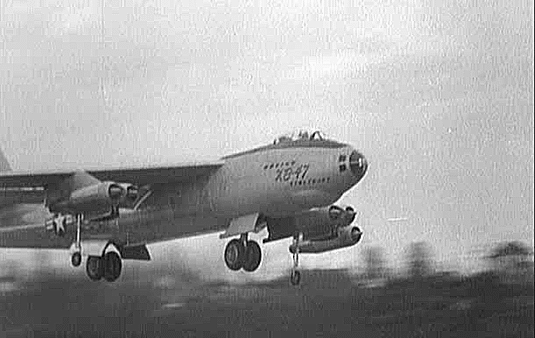
XB-47
#XB 47#Boeing#Jet Age#B47 Stratojet#Stratojet#GIF#my gifs#Cold War#Bomber#Warplane#Fiend Without a Face#Danny watches Fiend Without a Face#Hide and Queue
7 notes
·
View notes
Photo


Boeing B-47 Stratojet with either Rocket or Jet Assisted Takeoff.
11 notes
·
View notes
Photo
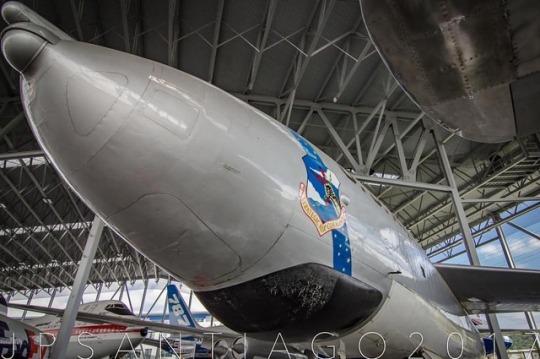
It’s so appropriate to have the Boeing B-47 Stratojet on display with the Boeing 747 and Boeing 787 prototypes at the Museum of Flight in Seattle- its layout with a thin swept wing and podded engines cantilevered from the wings by pylons set the layout for modern commercial jet aircraft with wing-mounted engines. The Stratojet’s genesis dates back to 1943 to a USAAF requirement for a jet reconnaissance bomber that was meant to spark the US manufacturers into researching jet bombers. By 1944, the requirement transitioned to a formal proposal for new jet bomber. North American and Convair were issued contracts for four engined bombers (which became the B-45 Tornado and the XB-46) and Boeing and Martin got contracts for six engined bombers (which became the Stratojet and the XB-48). In May 1945, Boeing’s chief of the technical staff, the aerodynamicist George Schairer, reviewed captured German wind tunnel data in Germany on swept wings and he wrote a famous letter ordering his team to stop work on the bomber and redesign it with swept wings. Analysis of the data Schairer sent back led to a 35-degree swept wing and progressive design refinement to meet the demanding performance goals led to the layout of the B-47. Assembly began in June 1947 and the first flight of the Stratojet was on 17 December 1947 on the anniversary of the Wright Brothers’ first flight just 44 years earlier. | October Aviation Photo Challenge | @kjdphoto1971 | #1017planes | “The Way We Were” | Day 25 | #Avgeek #aviation #aircraft #planeporn #KBFI #BFI #BoeingField #MuseumofFlight #airport #planespotting #Boeing #B47 #Stratojet #instagramaviation #aviationlovers #aviationphotography #Avgeekery #mil_aviation_originals #instaaviation #aviationlovers #aviationphotography #flight #AvgeekSchoolofKnowledge (at The Museum of Flight)
#aviationlovers#planespotting#flight#mil_aviation_originals#stratojet#aviationphotography#instaaviation#kbfi#boeing#aircraft#boeingfield#aviation#museumofflight#instagramaviation#planeporn#airport#1017planes#avgeekschoolofknowledge#bfi#avgeek#b47#avgeekery
1 note
·
View note
